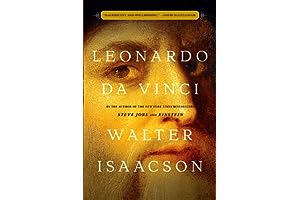One Sentence Summary
This book is an authoritative biography of renowned Renaissance artist and scientist Leonardo da Vinci by Walter Isaacson, one of the world’s leading biographers.
Book Genre
This is a biographical non-fiction book.
Main Topic of the Book
The main topic of this book is Leonardo da Vinci, his achievements in painting, science, and technology, and his overall impact on the world.
Key Ideas
- Exploration of the life and works of Leonardo da Vinci – The book offers an exploration of Leonardo’s life and works, from childhood to death. It covers his overall accomplishments, his struggles, and his total impact on the world.
- Analysis of his notebooks – The book provides a detailed analysis of Leonardo’s notebooks, offering insight into his creative process, his thoughts, and his inspirations.
- Investigation into his genius – Walter Isaacson investigates the genius of Leonardo da Vinci and his unique creative approach to life. He dives into Leonardo’s work and ideas, examining their impact on society.
Main Parts of the Book and a Short Summary
The book is divided into 8 parts, each one focusing on different aspects of Leonardo da Vinci’s life and works.
- Part One: Introduction – This part provides insight into the life of Leonardo da Vinci and his accomplishments, before throwing a spotlight on his scientific investigations, engineering feats, and inventions.
- Part Two: Childhood and Artistic Beginnings – This part covers Leonardo’s early years, from his humble beginnings as the illegitimate son of a notary until his apprenticeship with the master painter, Andrea del Verrocchio.
- Part Three: The Prodigy of Florence – This section covers Leonardo’s work during the early part of his career, as he was commissioned by many of the leading patrons of Florence and other cities in Italy.
- Part Four: Leonardo’s Mature Period – This part covers the period from 1499-1516, when Leonardo moved around Italy and was accepted into some of the most influential circles in France and Italy.
- Part Five: Last Years in Milan and France – This part covers the period in which Leonardo moved to Milan for the second time and then to France. It also covers his activities as a scientist and inventor in France.
- Part Six: Mind and Art – In this part, the book looks at the processes that fascinated Leonardo – such as optics, anatomy, biology, and botany.
- Part Seven: Machines and Inventions – This part covers the astounding inventions that Leonardo dreamt up and sketched in his notebooks. He is credited as the innovator who first conceptualized the helicopter, tank, and parachute, amongst other inventions.
- Part Eight: Last Days – This part tells the story of Leonardo’s last few years, recounting his death and the legacy that he left behind.
Key Takeaways
Readers will gain knowledge of Leonardo’s life and works, his struggles, and his total impact on the world. They will gain insight into his creative process, his thoughts, and his inspirations. Finally, readers will gain understanding of the genius of Leonardo da Vinci and his impact on society.
Author’s Background and Qualifications
The author of this book, Walter Isaacson, is a professor of history at Tulane University and a distinguished fellow and professor of history at the New Orleans Institute for the Humanities. Walter has written biographies on influential figures such as Albert Einstein, Steve Jobs, and Benjamin Franklin.
Target Audience
The primary audience of this book is anyone interested in learning about Leonardo da Vinci and his legacy. It is also suitable for anyone interested in biography, history, art, and science.
Publisher and First Publication Date
The book was originally published by Simon & Schuster in 2017.

